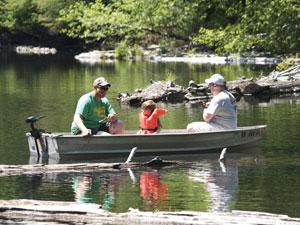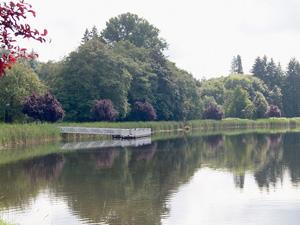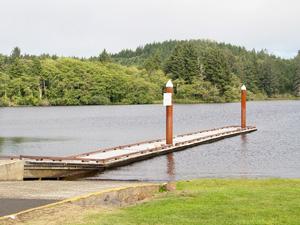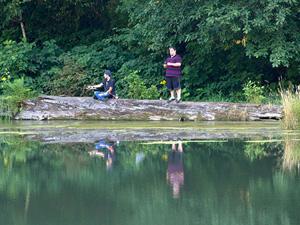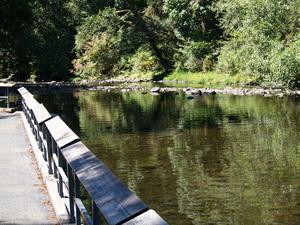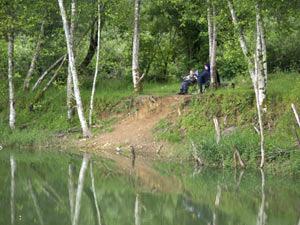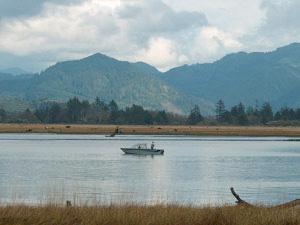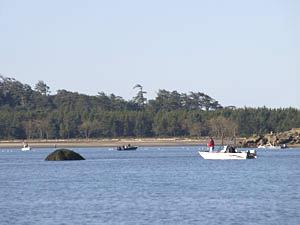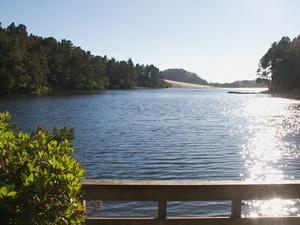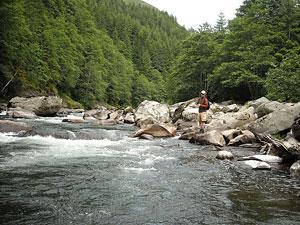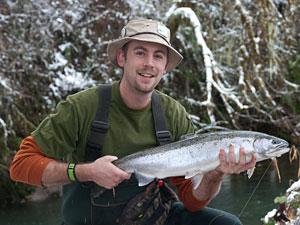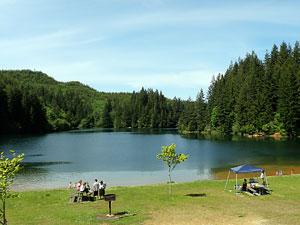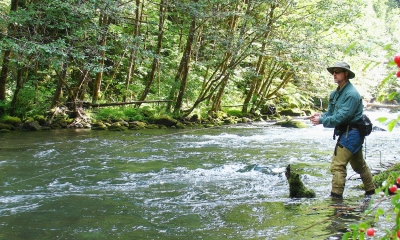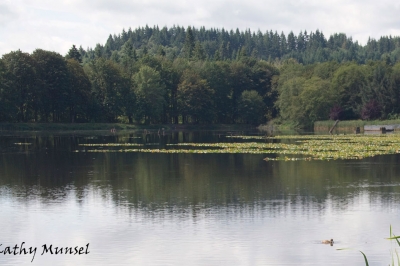
Easy angling in the Northwest Zone
A dozen great rivers pour out of the Coast Range Mountains into tidal bays that welcome runs of salmon and the sea-going rainbow trout called “steelhead.” Bays are the year-round home to marine perch, rockfish, crabs and clams, while other species come and go with the seasons and the tides. In the Northwest Zone a handful of ponds dot the forested slopes, and there are dozens of dune lakes— many stocked with plump rainbow trout, and some that grow their own largemouth bass, perch, crappie and brown bullhead.

Table of contents
Part 1: Easy Angling Oregon - An Introduction
Part 2: Easy Angling Oregon - Northwest Zone (you are here)
Part 3: Easy Angling Oregon - Southwest Zone
Part 4: Easy Angling Oregon - Willamette Zone
Part 5: Easy Angling Oregon - Central Zone
Part 6: Easy Angling Oregon - Southeast Zone
Part 7: Easy Angling Oregon - Northeast Zone
18 great places for families to fish in northwest Oregon
Featured waters:
- Coffenbury Lake
- Lost Lake
- Vernonia Pond
- Hebo Lake
- Cape Meares Lake
- Wilson River
- Cullaby Lake
- Tahoe Lake
- North Fork Nehalem River
- Lake Lytle
- Loren’s Pond
- Tillamook Bay
- Cleawox Lake
- Oregon Dune Lakes
- Yaquina Bay
- Siletz River
- Alsea River
- Olalla Creek Reservoir
Coffenbury Lake
Located in Fort Stevens State Park, where visitors can enjoy a variety of recreational opportunities such as fishing, clamming, hiking, biking and beach combing.
What to fish for:
Stocked with legal and larger-size trout in spring and fall. In summer, most fishing is for resident largemouth bass, yellow perch, bluegill and brown bullhead. Excess adult hatchery steelhead may be released in winter.
Fishing tips:
All lake-fishing techniques can be effective here. Use larger spoons and spinners and heavier (10 pound) line when targeting steelhead. Soon after stocking, trout are easily caught from platforms and banks. Later, there’s more action in less heavily fished areas.
Facilities:
Fort Stevens State Park: picnic area, accessible restrooms, accessible fishing pier or dock, campground, accessible showers, fee.
Getting there:
From Hwy 101 north of Seaside, follow signs to Fort Stevens State Park. Turn onto Ridge Rd., entering the park at the southernmost gate. There will be a sign for Coffenbury Lake and the campground.
Lost Lake
This relatively small lake – about 15 acres – is in a forested setting in the Nehalem drainage of the Coast Range Mountains. Good bank access around entire lake.
What to fish for:
Stocked with rainbow trout from March to mid-September. Surplus adult hatchery winter steelhead are stocked, when available, from December to February.
Fishing tips:
All lake-fishing techniques for trout can be effective. Fishing sand shrimp beneath a bobber can be productive for the surplus steelhead. Also suitable for float tubes, pontoons, canoes and other small boats.
Facilities:
Picnic area, campground, boat launch or ramp, toilets, fee.
Getting there:
Lost Lake is accessible via forest roads west of Hwy 26. Take Hwy 26 to Nehalem River Rd. Follow Nehalem River Rd. south about 8 miles to Spruce Run Park. From Hwy 101, take Miami River-Foley Creek Rd. to Foss Rd. Take Foss Rd. (becomes Nehalem River Rd.) northeast about 15 miles to Spruce Run Park. Turn east on Lost Lake Rd. and proceed about 5 miles to the lake.
Vernonia Pond
A fisher-friendly pond in the Vernonia City Park. A path encircling the pond provides lots of bank access, some of it wheelchair accessible. Two large docks provide additional access.
What to fish for:
Good fishing for stocked trout in spring and early summer. During warm summer months, bluegill, crappie, perch and largemouth bass fishing will be good. Surplus adult hatchery steelhead are released in the winter, when available.
Fishing tips:
All lake-fishing techniques for trout and warmwater fish can be effective here. No motors allowed.
Facilities:
Campground, accessible restrooms or toilet, boat launch, accessible fishing pier or dock.
Getting there:
The Pond is located on the south edge of Vernonia on Hwy 47. Take Hwy 26 west toward Seaside and follow the signs to Vernonia (about 43 miles from Portland).
Hebo Lake
This 3-acre lake has improved camp areas and good fishing access, including several fishing platforms. Camping and fishing access for persons with disabilities are available.
What to fish for:
Stocked with rainbow trout from mid-March to mid-June. Occasionally may be stocked with larger trout in the fall. Some larger holdover trout may be caught in early spring.
Fishing tips:
All lake-fishing techniques for trout will work here. Fishing is primarily from the bank although the lake is well-suited to small rafts, float tubes and canoes. Small boats can be launched off the bank.
Facilities:
Campground, accessible vault toilet, picnic area, accessible fishing pier or dock, fee.
Getting there:
Take Hwy 101 to Hwy 22 at Hebo. Travel 1/4 mile east on Hwy 22 to Forest Service Rd. 14. Travel east 4.5 miles on Forest Service Rd. 14 to the entrance of the Hebo Lake Campground.
Cape Meares Lake
This large, shallow lake is between Tillamook Bay and the ocean.
What to fish for:
Stocked with rainbow trout from March to June and again in September. During the warm summer months, anglers target warmwater species, primarily largemouth bass. Occasionally, surplus adult hatchery steelhead are stocked in the fall or winter.
Fishing tips:
All lake-fishing techniques can work here. Best fished in spring and fall -- aquatic vegetation can get thick in the warm summer months. Bank access along the road or out on the dike; also well-suited to canoes, kayaks and other small boats.
Facilities:
No facilities at the lake. Access to Tillamook Bay, Bayocean Spit, and the beach is available from a parking area located at the end of the dike road.
Getting there:
From Tillamook head west on 3rd St., then right on Bay Ocean Rd. Follow Bay Ocean Rd about five miles until you see the lake on your right.
Wilson River
One of Oregon’s most productive and scenic rivers -- and only 70 miles from the Portland area. Lots of bank access along Hwy 6 as the river bisects Tillamook State Forest. It’s also a good river for beginning drift boat operators with few hazards in the lower river and several possible floats.
What to fish for:
Summer and winter steelhead are available throughout the year. Fish for resident cutthroat trout in spring and fall, and larger sea-run cutthroat in July and August. Spring and fall Chinook also are available.
Fishing tips:
Target steelhead in deeper holes with a spinner or spoon, or bait (eggs or shrimp) drifted below a bobber. Fly fishing for steelhead also is popular. Salmon prefer deep pools where bobber and bait, backbouncing, or backtrolling are popular techniques. Cutthroat trout can be found in riffles, pools and near undercut banks. Small spinners, streamers or sometimes dry flies can be effective.
Facilities:
Supplies, restaurants and accommodations in Tillamook or at commercial establishments along the lower river.
Getting there:
Take Hwy 26 from Portland. Exit onto Hwy 6 to Tillamook. There are pullouts and good back access at several locations including Fall Creek, Herd Hole, Kansas Creek Bridge, Mills Bridge, Ming Creek, Siskeyville and Zig Zag Creek.
Cullaby Lake
Between Astoria and Seaside, this is a good place to take the family to fish for stocked trout and panfish.
What to fish for:
Rainbow trout are stocked in early spring. Target warmwater fish (largemouth bass, perch, bluegill and crappie) from late spring to late fall.
Fishing tips:
Standard lake-fishing techniques for trout and warmwater fish will work here. Look for warmwater species near cover such as overhanging brush or submerged vegetation.
Facilities:
Cullaby Lake County (Clatsop) Park: boat launch and docks, four stall flush restrooms, picnic area, parking, entrance or other day user fee.
Getting there:
From Astoria, take Hwy 101 south for 12 miles. The park is just east of Hwy 101.
Tahoe Lake
Looking to get off the beaten path? Consider this small trout pond in the upper reaches of the Trask River watershed. A trail around the lake provides good bank access.
What to fish for:
Stocked with rainbow trout in April and May. Some holdover trout may be available early in the season.
Fishing tips:
Standard lake fishing techniques for trout will work here.
Facilities:
Primitive
Getting there:
From Hwy 101 in Tillamook, follow 3rd St. east, then Trask River Rd. about 12.5 miles to the end of the pavement. Continue on main gravel road about 6.5 miles to a spur road on the right.
North Fork Nehalem
The Nehalem Fish Hatchery and adjacent timber land provide good bank access to this small stream with well-defined fishing holes and lots of fish.
What to fish for:
Winter steelhead from December to April.
Fishing tips:
This is a popular fishery, so expect to have company. A smart beginner will take some time to see what gear other anglers are using and how they’re fishing. The most popular fishing techniques are drift fishing, throwing spinners or a bobber and jig. The best winter steelhead fishing is in December and January.
Facilities:
North Nehalem Fish Hatchery: accessible restrooms or toilet, Nehalem Hatchery Barrier Free Fishing Platform offers additional access to anglers with a disabled angler permit, parking, entrance or other day use fee.
Getting there:
From Hwy 26, take Hwy 53 south to mile post 8. From Hwy 101, take Hwy 53 north for 11 miles.
Lake Lytle
Lake Lytle is a 65-acre lake located within the City of Rockaway Beach on the north Oregon coast.
What to fish for:
Stocked with rainbow trout from March through early May. Target largemouth bass in warm summer months.
Fishing tips:
Most lake-fishing techniques for trout and bass will work. Trout can be caught from fishing docks or from boats. Target bass in areas with submerged logs. Bass fishing will be more productive from a boat.
Facilities:
Restrooms or toilet, boat ramp, ADA accessible fishing dock.
Getting there:
From Portland take Hwy 6 West to Tillamook and head north on Hwy 101 approximately 15 miles to the north end of Rockaway Beach.
Loren’s Pond
This small, 3.5 acre pond is a former rock quarry located along the Trask River floodplain. Disabled access is available at the east end, and trails have been improved around much of the pond.
What to fish for:
Stocked with rainbow trout in March and April. Some surplus adult hatchery steelhead may also be stocked in winter.
Fishing tips:
Most lake-fishing techniques for trout will work here. Use larger spoons and spinners and heavier (10 pound) line when targeting steelhead. Fishing is primarily from the bank.
Facilities:
Accessible restrooms or toilet, accessible fishing pier or dock.
Getting there:
From Portland take Hwy 6 west to Olson Rd. (near Tillamook). Olson Rd. becomes Trask River Rd. Continue straight as you cross over the Trask River and you are now on Long Prairie Rd. Take the first left onto Chance Rd. and travel east 2.7 miles to Loren’s Drift access road. The pond and Trask River are accessed by this road.
Tillamook Bay
The 13 square-mile Tillamook Bay is well-known for its runs of Chinook salmon, but also offers opportunity for white sturgeon, a variety of marine fish species, Dungeness crab and bay clams. Multiple public bank access points and several well-maintained boat launches makes Tillamook Bay a great year-round choice for the angler.
What to fish for:
Rockfish, surf perch, greenling, lingcod, sturgeon, spring and fall Chinook, coho salmon, sea-run cutthroat trout. In addition to fishing, Tillamook Bay offers some of the best opportunities on the north coast for harvesting Dungeness crab and bay clams.
Fishing tips:
Marine Fish: Fish from the north jetty of Tillamook Bay year-round for rockfish, surfperch and other marine fish species. Hike or bike to the south jetty via Bayocean spit. Rubber jigs fished along the rocky shoreline, or bait such as sand shrimp fished within the rocks can be very productive.
Salmon: Spring Chinook are available in the bay from April through July, but fishing is best in May and June. Bank fishing areas are limited to a few pull-outs along Bay Ocean Rd on the upper Bay and an ADA accessible fishing platform on the Tillamook River along Hwy 131.
Fall Chinook begin to arrive in late August, with October usually the best month. There is bank access along the Tillamook River on Fraser Rd, and at the privately-owned Hospital Hole, where anglers can pay a small fee to access a long stretch of Trask River tidewater. Bobber and bait (usually salmon roe and/or sand shrimp) and spinners are typical bank fishing techniques for Chinook in Upper Tillamook Bay.
Sturgeon: In the winter and early spring, sturgeon are primarily caught from a boat in one of the bay’s many, shallow channels. From late spring through summer, bank anglers fish from a pull-out on Fraser Rd or the ADA platform on the lower Tillamook River. Common sturgeon baits include sand shrimp or mud shrimp.
Crabbing: Crabbing is generally the most productive in the lower one-third of the bay. The old coast guard pier off of 12th street in Garibaldi and the public dock at the southern end of the Garibaldi boat basin parking lot are good places for crabbing if you don’t have a boat. Baited rings or pots work best. Bait and ring rentals are available at the Garibaldi Marina. Some anglers use baited snares attached to fishing rods to catch crabs from these piers or along the jetties.
Clamming: Locating bay clams in Tillamook Bay
Facilities:
Memaloose Boat Ramp: Good boat launch for angling upper bay. Some bank angling available. Vault restrooms, boat ramp, parking, entrance or other day use fee.
Garibaldi Boat Basin: The marina offers boat and crab pot rentals. Good boat launch for fishing Ghost Hole, lower bay and ocean. Boat rentals, restrooms or toilet.
Barview County Park and North Jetty Access: Beach and jetty access. Campground, restrooms or toilet.
Tillamook River Tidewater Access -ADA Accessible Fishing Platform: Located on Netart’s Hwy (Hwy 131) just past the turn-off to Cape Meares and Bay Ocean Spit. Accessible restroom, ADA accessible fishing platform.
Other Launch Sites: The Tillamook Bay Water Trail Guidebook produced by the Tillamook Estuaries Partnership offers a detailed description of other boat launch sites associated with Tillamook Bay.
Getting there:
From Portland, take Hwy 6 west to Tillamook. From Tillamook, Hwy 131 and then Bay Ocean Rd provide access to the south end of the bay. The north end of the bay is accessed by traveling north on Hwy 101 through Garibaldi and Barview.
Cleawox Lake
This 82-acre lake is located within Honeyman State Park just south of Florence. The lake is flanked by dunes on its west shore and good bank fishing is available around much of the lake.
What to fish for:
Trout are stocked regularly from February through early June. Crappie, yellow perch, bluegill, brown bullhead and largemouth bass are available year-round.
Fishing tips:
All lake-fishing techniques can be effective here.
Facilities:
Honeyman State Park: boat launch or ramp, accessible restrooms or toilet, picnic area, campground, accessible shower, parking, entrance or other day use fee.
Getting there:
Turn west off Hwy 101 about 3 miles south of Florence, follow signs to Cleawox and Honeyman State Park. The park continues on the east side of the highway.
Oregon Dune Lakes: Alder, Buck, Dune
These three small lakes just north of Oregon Dune National Recreation Area provide good fishing for stocked trout. Good bank access and many nearby attractions and activities make them a great family destination. A campground/day use area between Alder and Dune lakes provides amenities and access.
What to fish for:
Stocked with hatchery rainbow trout from February through June.
Fishing tips:
Most standard lake-fishing techniques will work here.
Facilities:
USFS Alder Dune Campground and Day Use Area: campground, restrooms or toilet picnic area, parking, entrance or other day use fee
Getting there:
From Florence, take Hwy 101 north 4.1 miles to campground sign. Turn left into campground.
Yaquina Bay
Home to the city of Newport, this is one of the most popular and productive bays on the Oregon Coast. Anglers can catch everything from rockfish to crabs to salmon.
What to fish for:
Marine perch, rockfish, herring, sturgeon, fall Chinook, clams, crabs
Fishing tips:
- Rockfish: Fish both jetties year-round using leadhead jigs with plastic worms.
- Herring: Available February through March. Fish from public fishing docks at South Beach Marina by jigging with a small bare hook and yarn.
- Crab: Available year-round. Good access at the public fishing docks. Use crab pots or traps to discourage bait-stealing seals. Crab pots are available for rent at South Beach Marina.
- Clams: Dig for bay clams downstream of the Hwy 101 bridge and off the Science Center parking lot.
- Salmon: Fall Chinook are available from September through early November. There are several bank fishing opportunities along the Yaquina Bay road and the Elk City Rd (County Rd. 533) between Toledo and Elk City. From the bank use large spinners, size 4-5.
Facilities:
South Beach Marina: fishing pier, fish cleaning stations, restroom, picnic area, boat launch or ramp.
Gas Plant (along north shore): fishing pier or dock, accessible .
South Beach State Park: Good access to beach and jetty. Accessible campground, accessible restrooms or toilet, picnic area, accessible shower.
Getting there:
Turn east off Hwy 101 at Newport and follow signs to either South Beach (to fish south shore and jetty) or Yaquina Bay Road (to fish the north shore).
Siletz River
A wild and scenic coastal stream, far enough inland to avoid the worst ocean weather. Best fishing is in the upper river between Morgan Memorial Park and Moonshine Park. Some good bank access from Hwy 229.
What to fish for:
Fall Chinook, winter and summer steelhead, sea-run cutthroat trout
Fishing tips:
Steelhead are available almost year-round; tailouts below riffles and deep holes and slots are good places to target them. Fall Chinook enter the bay in August-September and will begin to push upriver after a good fall rain. Favorite bank fishing tactics include casting large spinners or the typical egg and bobber set up. Sea-run cutthroat trout will head upstream from mid summer through early fall. Use spinners or streamers in deep pools or along undercut banks.
Facilities:
Jack Morgan Park (Lincoln County): campground, vault restrooms, picnic area, boat ramp.
Moonshine Park (Lincoln County): campground, accessible restrooms or toilet, boat launch or ramp, picnic area, parking, entrance or other day use fee.
Getting there:
From Hwy 101 in Kernville, travel east on Hwy 229 18 miles to the entrance to Jack Morgan Park. To get to Moonshine Park, continue on Hwy 229 to the town of Siletz. From there, head east on County Rd. 410 “Logsden Road” for 7.5 miles and turn left on to Moonshine Park Rd. Travel 4 miles to park entrance.
Alsea River
Originating in the Coast Range just west of Corvallis, this river flows 55 miles to the ocean at Alsea Bay. Hwy 34 parallels the river for most of its length offering excellent access for boat and bank fishing. Good bank access is available through several parks and campgrounds.
What to fish for:
Resident cutthroat trout, sea-run cutthroat, fall Chinook, winter steelhead.
Fishing tips:
Target resident cutthroat in early summer and fall with small rooster tails and other lures. Switch to larger, brighter lures in late summer to attract the more aggressive sea-run cutthroats.
Fall Chinook begin entering the bay in August but won’t move upriver until fall rains bring water levels up. Best fall Chinook fishing is in October to early November. Popular choices for bank anglers include large salmon spinners or drifting bait (eggs or sand shrimp) below a bobber. Winter steelhead begin entering the river in late November and fishing for them can be good into March. Both spinners and bobber and jig outfits will work.
Facilities:
Salmonberry County (Benton) Park: campground, accessible flush restrooms, boat launch or ramp.
Campbell Boat Landing (Benton County): restrooms or toilet, boat launch or ramp.
Mill Creek County (Benton) Park: restrooms or toilet, picnic area, boat launch or ramp.
USFS Rivers Edge Campground: campground, vault toilet, parking, entrance or other day use fee.
USFS Blackberry Campground: campground, accessible restrooms or toilet, boat launch, parking, entrance or other day use fee.
Getting there:
From Corvallis take Hwy 20 west about 5 miles to west end of Philomath. Take Hwy 34 southwest approximately 18 miles to the mainstream Alsea River.
Olalla Creek Reservoir
Olalla Creek Reservoir is a beautiful, 120-acre reservoir at the headwaters of Olalla Creek about nine miles northeast of Newport. Much of the surrounding landscape is owned by Georgia Pacific Corporation, which allows public access to the property from dawn until dusk throughout the year, and is managed as commercial timberland.
What to fish for:
The reservoir is frequently stocked with hatchery rainbow trout and also supports a population of native cutthroat trout. In addition, the reservoir contains some bass, brown bullhead and yellow perch, although these species are less abundant. Occasionally, hatchery steelhead from the Siletz River are also released in Olalla Reservoir.
Fishing tips:
All lake-fishing techniques for trout can be effective. Boats with electric motors are allowed on the reservoir but those with gas engines are not. There is decent bank access along much of the shoreline. The banks drop off quickly to a maximum depth of 65 feet. The most popular bank fishing areas are between the dam and the boat ramp.
Facilities
Restrooms or toilet, boat launch or ramp, picnic area
Getting there:
From Newport, take Hwy 20 east for approximately six miles, then head north on Olalla Rd. for about three miles.
Header photo by Kathy Munsel



